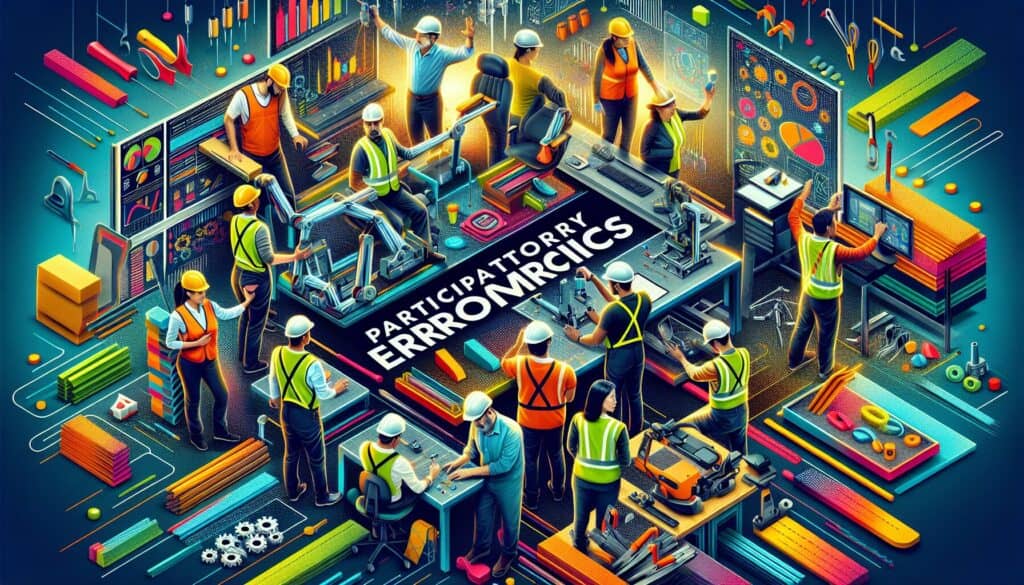Aktive Beteiligung der Arbeitnehmer an der Identifizierung, Analyse und Kontrolle ergonomisch Risiken an ihrem eigenen Arbeitsplatz und in ihrem Arbeitsumfeld.
- Methodologien: Kunden & Marketing, Wirtschaft, Produktdesign
Partizipative Ergonomie (mit Beteiligung der Arbeitnehmer)

Partizipative Ergonomie (mit Beteiligung der Arbeitnehmer)
- Kontinuierliche Verbesserung, Ergonomie, Menschliche Faktoren, Human-Centered Design, Schlanke Fertigung, Problemlösungs-Techniken, Prozessverbesserung, Teamarbeit, Benutzerzentriertes Design
Zielsetzung:
Wie es verwendet wird:
- Bildet Teams aus Arbeitnehmern, Vorgesetzten und Ergonomieexperten, um gemeinsam ergonomische Probleme zu ermitteln, Lösungen zu erarbeiten und Verbesserungen umzusetzen und zu bewerten.
Vorteile
- Erhöht die Beteiligung und die Eigenverantwortung der Arbeitnehmer für Lösungen; nutzt das direkte Wissen der Arbeitnehmer über ihre Aufgaben; führt oft zu praktischeren und nachhaltigeren Lösungen.
Nachteile
- Es kann zeitaufwändig sein, den Beteiligungsprozess zu steuern; erfordert Schulungen für Arbeitnehmer und Management; kann zu widersprüchlichen Meinungen oder unrealistischen Vorschlägen führen, wenn er nicht gut moderiert wird.
Kategorien:
- Ergonomie, Herstellung, Qualität
Am besten geeignet für:
- Direkte Einbindung der Arbeitnehmer in den Prozess der Ermittlung und Lösung ergonomischer Probleme an ihren Arbeitsplätzen.
Partizipative Ergonomie ist besonders in Sektoren wie der Fertigung, dem Gesundheitswesen und Büroumgebungen von Vorteil, wo physische Aufgaben und die Gestaltung des Arbeitsplatzes die Sicherheit und Produktivität der Mitarbeiter erheblich beeinflussen. In der Entwurfsphase eines neuen Arbeitsplatzes oder einer neuen Ausrüstung kann diese Methodik durch Workshops und Brainstorming-Sitzungen unter Einbeziehung eines vielfältigen Teams von Mitarbeitern, die die Aufgaben ausführen, Vorgesetzten, die die Arbeitsabläufe verwalten, und Ergonomieexperten, die die Grundsätze der optimalen Gestaltung verstehen, wirksam umgesetzt werden. Die Zusammenarbeit zwischen diesen Beteiligten ermöglicht nicht nur eine umfassende Identifizierung ergonomischer Herausforderungen, sondern fördert auch innovative Lösungen, die auf realen Anwendungen basieren. In verschiedenen Branchen wurde dieser Ansatz erfolgreich angewandt, um die Arbeitszufriedenheit und die Produktivität zu steigern und gleichzeitig die Zahl der Verletzungen am Arbeitsplatz zu verringern. In der Fertigung können die Mitarbeiter beispielsweise Feedback zur Anordnung der Maschinen und zur Zugänglichkeit von Werkzeugen geben, während im Gesundheitswesen das Pflegepersonal Probleme bei Hebetechniken oder der Platzierung von Geräten erkennen kann, die sich auf die Patientenversorgung auswirken. Die Einbindung der Mitarbeiter auf diese Weise fördert eine Kultur der kontinuierlichen Verbesserung, da sie sich an den Lösungen beteiligen, die sie mitgestalten, wodurch es wahrscheinlicher wird, dass Änderungen effektiv umgesetzt und langfristig beibehalten werden. Wenn die Teams die vorgenommenen Änderungen regelmäßig bewerten und weitere Anregungen einholen, entsteht ein ständiger Dialog, der die Anpassungsfähigkeit an sich verändernde Aufgaben und Technologien fördert. Der Erfolg dieser Initiativen veranlasst Unternehmen häufig dazu, ständige Ergonomieausschüsse oder Arbeitsgruppen einzurichten, die regelmäßig die Arbeitsplatzbedingungen bewerten und sich für von den Mitarbeitern angeregte Verbesserungen einsetzen.
Die wichtigsten Schritte dieser Methodik
- Ermitteln Sie ergonomische Probleme durch interaktive Diskussionen mit den Arbeitnehmern.
- Führen Sie Brainstorming-Sitzungen durch, um Ideen für Verbesserungen zu entwickeln.
- Priorisierung der ermittelten Lösungen auf der Grundlage von Machbarkeit und Auswirkungen.
- Entwicklung von Aktionsplänen für die Umsetzung der ausgewählten Lösungen in Zusammenarbeit.
- Durchführung der Aktionspläne unter Einbeziehung der Arbeitnehmer in den Prozess.
- Überwachung und Bewertung der Auswirkungen der umgesetzten Lösungen durch Rückmeldungen der Arbeitnehmer.
- Auf der Grundlage der Bewertungsergebnisse und des laufenden Inputs der Mitarbeiter werden die Lösungen weiterentwickelt.
Profi-Tipps
- Führen Sie regelmäßig Workshops durch, in denen die Arbeitnehmer ihre Bedenken äußern und Vorschläge für ergonomische Verbesserungen machen können, um einen ständigen Dialog über die Sicherheit am Arbeitsplatz zu fördern.
- Nutzen Sie während der Brainstorming-Sitzungen kollaborative Werkzeuge und visuelle Hilfsmittel wie Skizzen oder 3D-Modelle, um die Diskussionen auf greifbare Lösungen zu lenken.
- Festlegung von Maßstäben für die Bewertung ergonomischer Maßnahmen, um sicherzustellen, dass Feedbackschleifen für eine kontinuierliche Verbesserung auf der Grundlage realer Anwendungen und Nutzererfahrungen vorhanden sind.
Verschiedene Methoden lesen und vergleichen, Wir empfehlen die
> Umfassendes Methoden-Repository <
zusammen mit den über 400 anderen Methoden.
Ihre Kommentare zu dieser Methodik oder zusätzliche Informationen sind willkommen auf der Kommentarbereich unten ↓ , sowie alle ingenieursbezogenen Ideen oder Links.
Historischer Kontext
1986
(wenn das Datum nicht bekannt oder nicht relevant ist, z. B. "Strömungsmechanik", wird eine gerundete Schätzung des bemerkenswerten Erscheinens angegeben)

Verwandte Artikel
Monte-Carlo-Simulation
Modellbasiertes Testen
Modellprüfung
Forschung mit gemischten Methoden
Fehlervermeidung (Poka-Yoke)
Prüfung des Missionsprofils